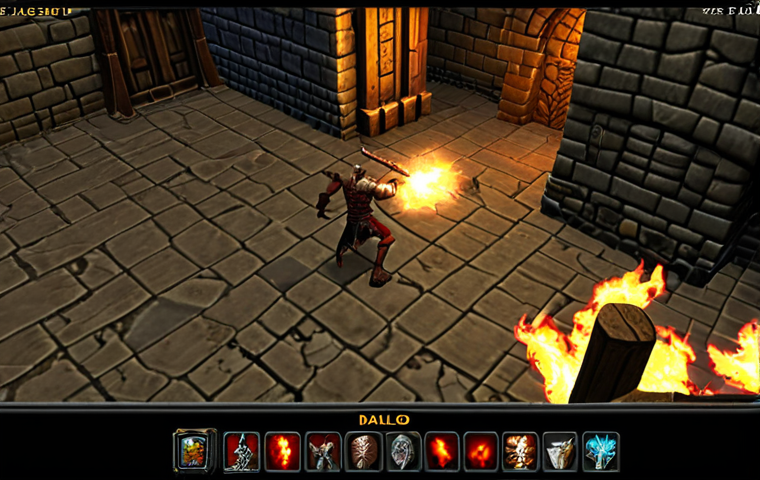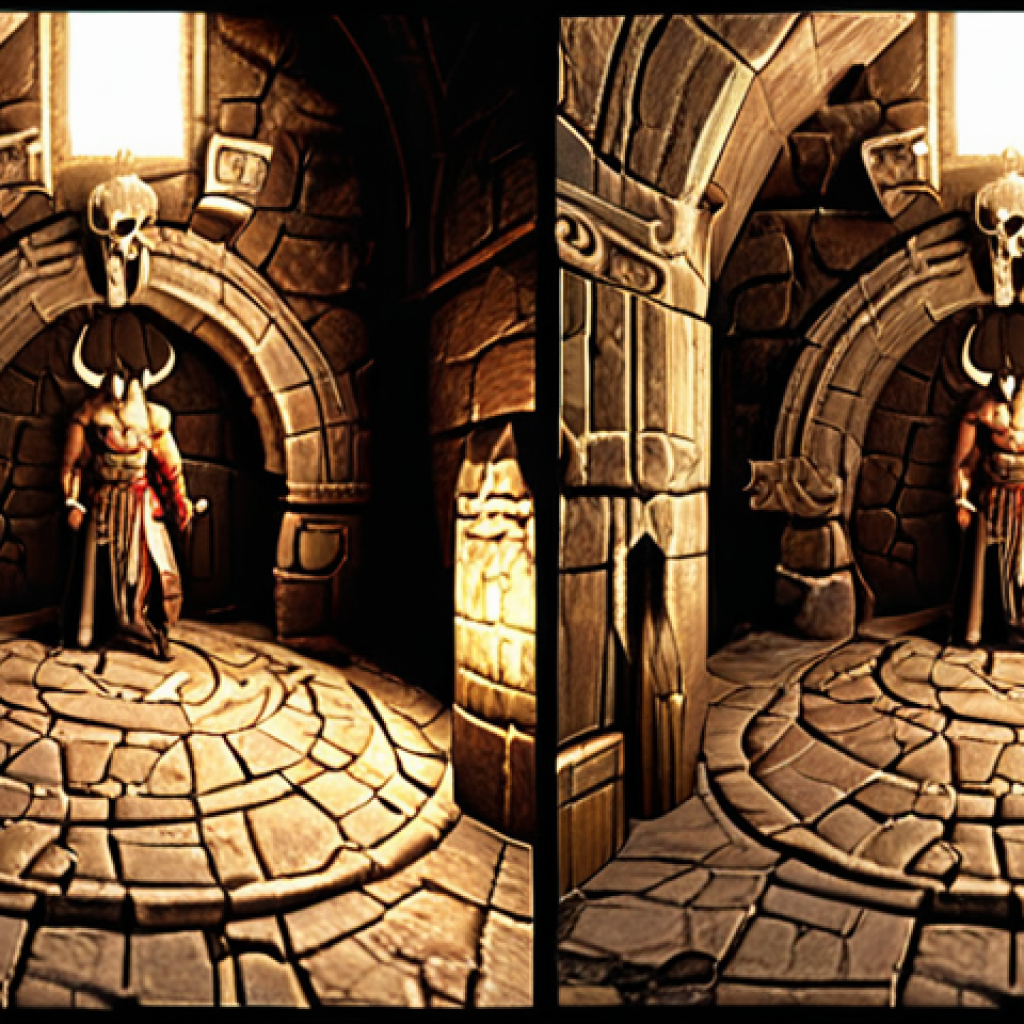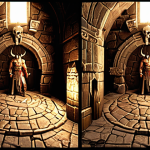Diablo II, a timeless classic, still holds a special place in many gamers’ hearts. But let’s be honest, those graphics are showing their age! Getting the settings just right can be the difference between a blurry mess and a surprisingly decent-looking experience.
It’s not just about cranking everything to max; it’s about finding that sweet spot between visual clarity and performance, especially on modern systems.
I’ve spent countless hours tweaking these settings myself, trying to relive that nostalgic glory without my eyes bleeding. It’s a journey worth taking to rediscover this gem in its best possible light.
Let’s dive in and get those visuals optimized. Let’s get into the nitty-gritty and see how we can make Diablo II look its best! Let’s get to the heart of the matter below!
Alright, let’s get Diablo II looking its best. Here’s how to fine-tune those graphics settings for a modern experience:
Unlock the Potential: Graphic Settings to Tweak First

1. Resolution Revolution: Going Beyond 800×600
Okay, let’s be real – playing Diablo II in its original resolution on a modern monitor is like looking through a keyhole. The first step is to bump that resolution up! This usually involves tweaking some files outside the game, namely the D2VidTst.exe. Running this will give you a compatibility test, but more importantly, it’ll generate a text file where you can manually enter your desired resolution. I usually aim for at least 1920×1080, but experiment to see what your system can handle. Just remember to back up the original file before you start tinkering. Trust me, the difference is night and day. It’s like upgrading from a flip phone to a smartphone – suddenly, everything is crisp and clear.
2. Glide Wrapper: The Secret Sauce for Smoothness
Diablo II was designed for older versions of DirectX and Glide, which modern graphics cards don’t natively support very well. Enter the Glide wrapper. This nifty piece of software translates Glide API calls into something your GPU understands, resulting in improved performance and stability. I personally use Sven’s Glide Wrapper (just Google it – it’s easy to find), and it’s made a world of difference. Installation is straightforward: drop the files into your Diablo II directory, configure the settings (there’s a handy configuration tool included), and you’re good to go. You’ll notice smoother animations, reduced lag, and an overall more pleasant visual experience. Think of it as giving your old car a brand-new engine – it still looks the same on the outside, but under the hood, it’s a completely different beast.
3. Compatibility Mode: Taming the Wild West of Windows
Sometimes, older games just don’t play nice with newer operating systems. That’s where compatibility mode comes in. Right-click on your Diablo II executable (usually Diablo II.exe or Game.exe), go to Properties, and then the Compatibility tab. Experiment with different compatibility modes, starting with Windows XP Service Pack 3. Run the game as an administrator while you’re at it – this can often resolve permission issues that might be causing crashes or glitches. It’s like putting a grumpy old man in a comfortable chair – sometimes, all he needs is a little bit of understanding (and the right settings) to behave himself.
Fine-Tuning Visuals: Beyond Basic Settings
1. Texture Filtering: Sharpening the Details
While Diablo II’s textures are inherently low-resolution, you can still improve their appearance with texture filtering. In your graphics card control panel (Nvidia Control Panel or AMD Radeon Settings), find the settings for Diablo II and experiment with different texture filtering modes. Anisotropic filtering (AF) is generally the best option, as it improves the clarity of textures at oblique angles, reducing blurriness. I usually set it to 8x or 16x, depending on my system’s capabilities. It’s like putting on a new pair of glasses – suddenly, you can see all the fine details that you were missing before.
2. Color Depth: Embracing the Full Spectrum
Ensure your game is running in 16-bit or 32-bit color mode. This might seem obvious, but sometimes older games default to lower color depths, resulting in washed-out or inaccurate colors. You can usually adjust this in the game’s settings or through your graphics card control panel. A richer color palette can significantly enhance the overall visual experience, making the world of Sanctuary feel more vibrant and immersive. Think of it as adding a splash of color to a black-and-white photograph – it brings the whole scene to life.
3. Gamma Correction: Finding the Perfect Balance
Gamma correction affects the overall brightness and contrast of the game. Adjusting the gamma settings can help you see better in dark areas without washing out the bright areas. Experiment with the gamma settings in the game’s options menu until you find a balance that suits your preferences. A well-adjusted gamma setting can make a huge difference in visibility, especially in dungeons and caves. It’s like adjusting the brightness on your TV – too bright, and everything is washed out; too dark, and you can’t see anything. Finding the sweet spot is key.
Performance Tweaks: Smooth Gameplay is King
1. Vertical Sync (V-Sync): Eliminating Screen Tearing
Screen tearing occurs when your graphics card outputs frames faster than your monitor can display them, resulting in a visible tear in the image. Vertical Sync (V-Sync) synchronizes your game’s frame rate with your monitor’s refresh rate, eliminating screen tearing. However, V-Sync can also introduce input lag, so it’s a trade-off. I usually try playing with V-Sync both on and off to see which works best for me. If screen tearing is particularly noticeable, enabling V-Sync is generally the way to go. It’s like smoothing out a bumpy road – it might slow you down slightly, but the ride is much more comfortable.
2. Frame Rate Limiter: Preventing Overdrive
If your system is powerful enough to run Diablo II at very high frame rates, you might experience performance issues or overheating. Using a frame rate limiter can cap the frame rate, preventing your system from working harder than it needs to. I usually set the frame rate limit to my monitor’s refresh rate (e.g., 60Hz or 144Hz). This can help reduce stress on your GPU and CPU, resulting in a more stable and consistent gaming experience. It’s like putting a speed limiter on your car – you might not be able to go as fast, but you’ll save gas and reduce wear and tear.
3. Background Processes: Closing Unnecessary Programs
Before launching Diablo II, close any unnecessary programs running in the background. These programs can consume system resources, impacting the game’s performance. This includes web browsers, music players, and other applications that you’re not actively using. Freeing up system resources can significantly improve Diablo II’s performance, especially on older systems. It’s like decluttering your desk – the more space you have, the easier it is to work.
Advanced Tweaks: For the Truly Dedicated
1. DirectDraw Compatibility: A Last Resort
In some cases, Diablo II might have issues with DirectDraw, an older graphics API. If you’re experiencing graphical glitches or crashes, try running the game in DirectDraw compatibility mode. This can be enabled by adding the “-direct” command-line argument to the game’s shortcut. Right-click on the shortcut, go to Properties, and add “-direct” to the end of the Target field. It’s like using a workaround to fix a broken pipe – it might not be the ideal solution, but it can get the job done.
2. CPU Affinity: Assigning Cores
On multi-core processors, you can try assigning Diablo II to specific CPU cores. This can sometimes improve performance by preventing the game from being spread across all cores, which can lead to inefficiencies. To do this, launch Diablo II, then open Task Manager (Ctrl+Shift+Esc). Go to the Details tab, find the Diablo II process, right-click on it, and select Set Affinity. Experiment with different core assignments to see which works best for you. It’s like giving each chef in a kitchen a specific task, rather than having everyone try to do everything at once.
3. Modding: Exploring Visual Enhancements
The Diablo II modding community is alive and well, with numerous mods available that enhance the game’s graphics. These mods can include higher-resolution textures, improved lighting effects, and other visual enhancements. However, installing mods can be tricky, and it’s important to download them from reputable sources to avoid malware. Before installing any mods, make sure to back up your Diablo II installation. It’s like giving your house a makeover, with new furniture and decor, but you want to be sure you have insurance for the renovation.
Troubleshooting Common Issues
1. Graphics Card Driver Updates: Staying Current
Make sure your graphics card drivers are up to date. Outdated drivers can cause compatibility issues and performance problems. Visit the Nvidia or AMD website to download the latest drivers for your graphics card. Newer drivers often include optimizations for older games, so it’s always worth checking for updates. It’s like making sure your car has the latest software update – it can improve performance and fix bugs.
2. Error Messages: Deciphering the Code
Pay attention to any error messages that appear when launching or playing Diablo II. These messages can provide valuable clues about the cause of the problem. Search online for the error message to find possible solutions. The Diablo II community is very active, so there’s a good chance someone else has encountered the same problem and found a fix. It’s like getting a diagnostic code from your car – it can help you pinpoint the problem.
3. Reinstalling Diablo II: The Nuclear Option
If all else fails, try reinstalling Diablo II. This can often resolve issues caused by corrupted files or incorrect settings. Before reinstalling, make sure to back up your save files. This is the most drastic step, but it can sometimes be the only way to get the game running properly. It’s like formatting your computer – it wipes everything clean and starts fresh.
Optimized Settings Table
| Setting | Recommendation | Reason |
|---|---|---|
| Resolution | 1920×1080 or higher | Increases visual clarity |
| Glide Wrapper | Install and configure Sven’s Glide Wrapper | Improves performance and stability |
| Compatibility Mode | Windows XP Service Pack 3 | Addresses compatibility issues |
| Texture Filtering | Anisotropic Filtering (8x or 16x) | Sharpens textures |
| Color Depth | 16-bit or 32-bit | Ensures accurate colors |
| Vertical Sync (V-Sync) | Experiment with On/Off | Eliminates screen tearing but can introduce input lag |
| Frame Rate Limiter | Match monitor’s refresh rate | Prevents overheating and performance issues |
By tweaking these settings, you can breathe new life into Diablo II and enjoy this classic game in a way that’s both visually appealing and performs well on modern hardware.
Happy slaying!
Wrapping Up
So, there you have it! Diablo II, looking and playing its best on modern hardware. It might take a little tinkering, but the results are well worth the effort. Now you can dive back into Sanctuary with sharper visuals and smoother gameplay, ready to face the Lord of Terror once again. Happy hunting, and may your drops be ever in your favor!
Handy Information
1. Backup is Key: Always back up your Diablo II directory before making any changes to game files or installing mods. This can save you a lot of headaches if something goes wrong.
2. Community Resources: The Diablo II community is a wealth of knowledge. Check out forums, Reddit, and YouTube for tutorials, troubleshooting tips, and mod recommendations.
3. Hardware Considerations: Keep in mind that Diablo II, even with graphics enhancements, is still an older game. Modern GPUs should handle it with ease, but older systems might struggle with higher resolutions and texture filtering.
4. Experimentation is Encouraged: Don’t be afraid to experiment with different settings to find what works best for your system and personal preferences. There’s no one-size-fits-all solution.
5. Sven’s Glide Wrapper Config: In Sven’s Glide Wrapper config, try enabling “Desktop resolution” for fullscreen, helps with stretching issues if using a widescreen monitor!
Key Takeaways
Optimizing Diablo II’s graphics involves tweaking settings, using Glide wrappers, and ensuring compatibility. Proper settings will provide an enhanced experience and a smoother gameplay. Experimentation and keeping your drivers up to date is necessary.
Frequently Asked Questions (FAQ) 📖
Q: My Diablo II characters look kinda blocky and the game seems stretched. How do I fix that without making it look even worse?
A: Ah, the classic “blocky characters” issue. I feel your pain! The best way to tackle this is to enable Glide mode if you haven’t already.
Many players, myself included, swear by it. You’ll need a Glide wrapper (like the one from Sven Labs – easy to find with a quick Google search). Install it, then configure Diablo II to use it as the graphics renderer.
Within the Glide settings, you can typically force higher resolutions and use filtering options that smooth out those jagged edges. Experiment a little, but generally, a 2x or 4x upscaling factor with bilinear filtering can make a world of difference.
Also, make sure your in-game resolution is set to the highest available – often 800×600. It’s not HD, but Glide makes it much more palatable!
Q: I’m running Diablo II on a modern widescreen monitor, and the game looks… squished and stretched. How can I get it to display properly without weird black bars or distortion?
A: Dealing with widescreen on Diablo II is a bit of a dark art, but there are solutions! The easiest method is to use a mod like “D2SE” (Diablo II SE). It’s basically a launcher that lets you apply various patches and mods, including one that expands the resolution to widescreen.
Just install D2SE, then find a widescreen resolution mod that works for your version of Diablo II. Another popular option is to simply accept the black bars on the sides, which maintains the original aspect ratio and prevents distortion.
If you’re feeling adventurous, you can even try editing the game’s configuration files manually, but that can be a bit of a pain and might lead to instability.
I personally prefer D2SE – it’s the most user-friendly solution I’ve found.
Q: Even with updated graphics settings, my game sometimes lags or stutters, especially in crowded areas. What can I do to improve performance without sacrificing too much visual quality?
A: Ah, the dreaded lag! That’s usually down to Diablo II not being optimized for modern hardware. First, try running Diablo II in compatibility mode for Windows XP or Windows 7.
Right-click the Diablo II shortcut, go to Properties, then the Compatibility tab, and check the box that says “Run this program in compatibility mode for.” Next, close any unnecessary background programs, especially web browsers, Discord, or anything else that might be eating up your CPU or memory.
Also, even if you have a powerful graphics card, try lowering some of the graphics settings in the game options, especially things like lighting quality, spell effects detail, and shadow quality.
Lowering these settings can give you a surprisingly big performance boost without making the game look significantly worse. Finally, make sure your graphics card drivers are up to date!
Sometimes outdated drivers can cause performance issues. If all else fails, consider using a tool like Razer Cortex to automatically optimize your system resources before launching the game.
I remember spending hours tweaking these settings back in the day, trying to get the game to run smoothly on my potato PC!
📚 References
Wikipedia Encyclopedia
구글 검색 결과
구글 검색 결과
구글 검색 결과
구글 검색 결과
구글 검색 결과



